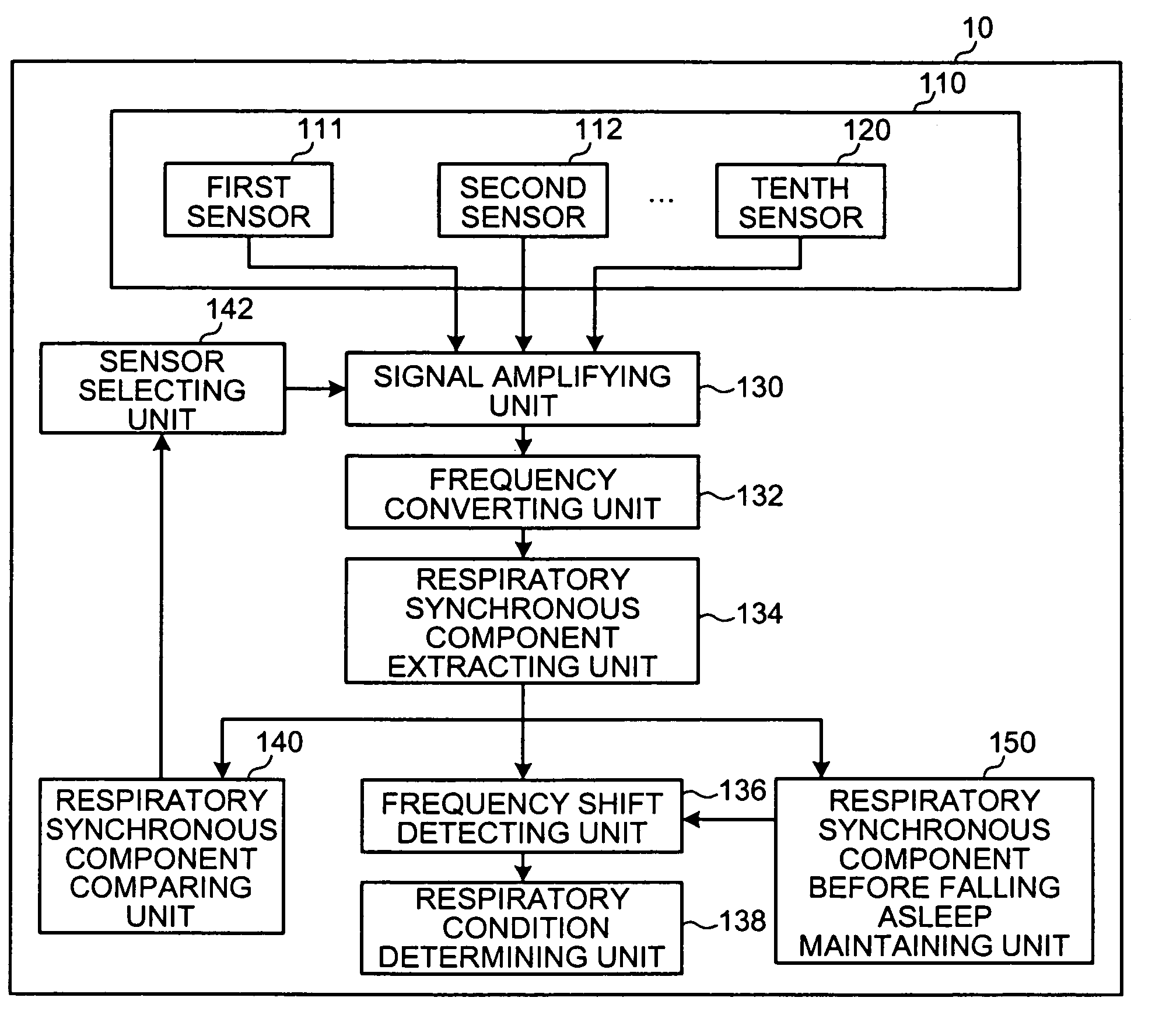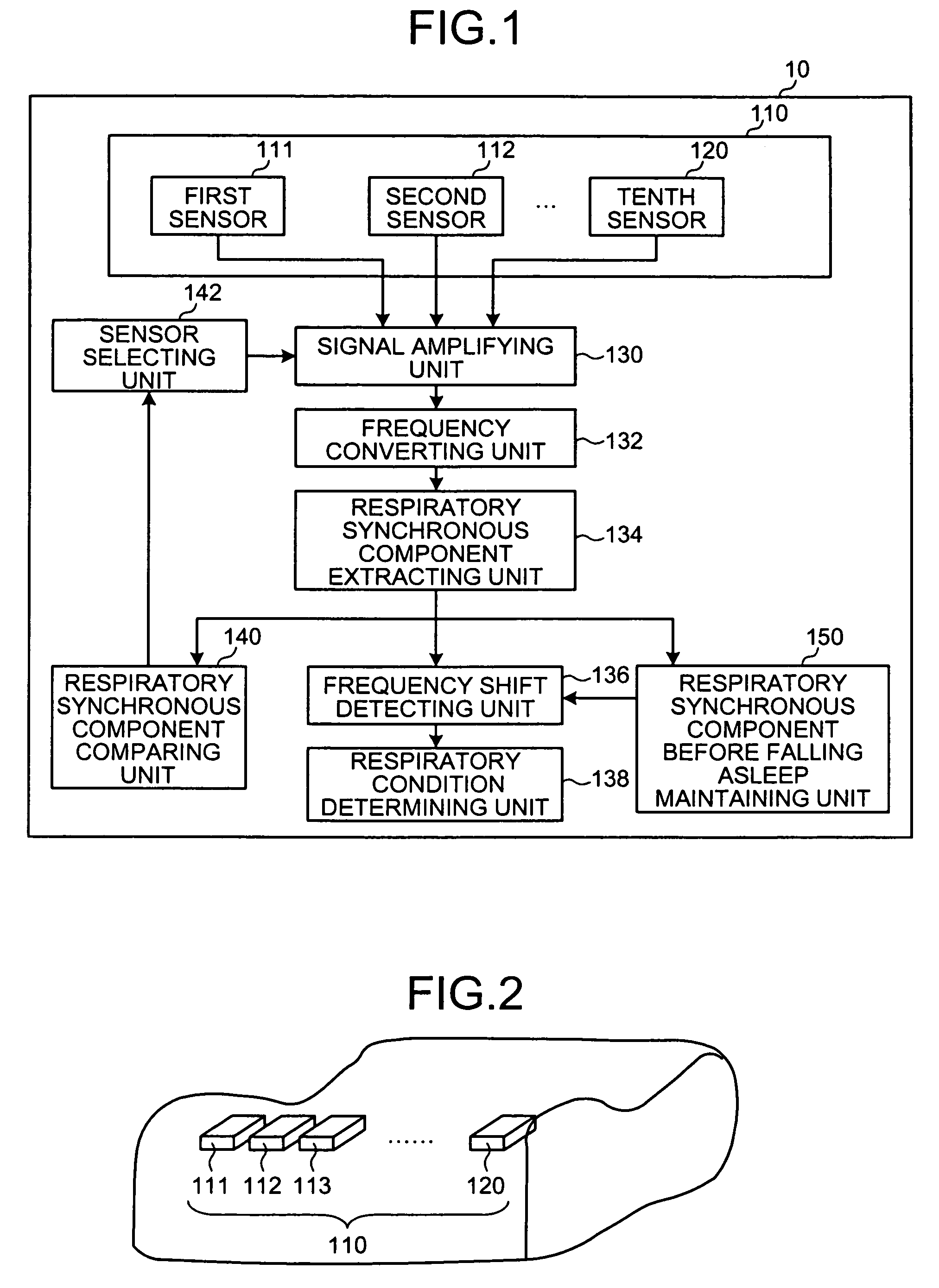Apparatus, method and computer program product for determining respiratory condition
a technology of respiratory condition and apparatus, applied in the field of apparatus, a method and a computer program product for determining respiratory condition, can solve problems such as improper pillow height, road accidents, and people experiencing hypoxic condition
- Summary
- Abstract
- Description
- Claims
- Application Information
AI Technical Summary
Problems solved by technology
Method used
Image
Examples
first embodiment
[0025]FIG. 1 is a block diagram illustrating an entire configuration of an apparatus for determining a respiratory condition 10 according to a first embodiment of the present invention. The apparatus for determining a respiratory condition 10 includes a sensor array 110 having a plurality of sensors 111 to 120 that detect breath sounds passing through a subject's airway while being in contact with the subject's skin, a signal amplifying unit 130, a frequency converting unit 132, a respiratory synchronous component extracting unit 134, a frequency shift detecting unit 136, a respiratory condition determining unit 138, a respiratory synchronous component comparing unit 140, a sensor selecting unit 142, and a respiratory synchronous component, before falling asleep, maintaining unit 150.
[0026]The signal amplifying unit 130 amplifies breath sound signals detected from the respective sensors 111 to 120. The frequency converting unit 132 performs frequency conversion, such as Fourier tran...
second embodiment
[0067]FIG. 9 is a diagram illustrating the external appearance of an apparatus for determining a respiratory condition 10 according to a second embodiment. A plurality of air bags 301 to 310 are provided under respective sensors 111 to 120. In this case, one air bag is provided so as to correspond to one sensor. The air bag according to the present embodiment corresponds to a pressing member described in the appended claims.
[0068]FIG. 10 is a block diagram illustrating a functional configuration of the apparatus for determining a respiratory condition 10 according to the second embodiment. The apparatus for determining a respiratory condition 10 according to the second embodiment further includes an air bag controlling unit 160, in addition to the functional configuration of the apparatus for determining a respiratory condition 10 according to the first embodiment. The air bag controlling unit 160 outputs to the air bag an instruction that the air bag, on which a sensor selected by ...
third embodiment
[0078]FIG. 11 is a block diagram illustrating a functional configuration of an apparatus for determining a respiratory condition 10 according to a third embodiment. The apparatus for determining a respiratory condition 10 according to the third embodiment does not include the respiratory synchronous component comparing unit 140 and the sensor selecting unit 142. In addition, only one sensor is provided. In this configuration, the apparatus for determining a respiratory condition 10 according to the third embodiment is different from the apparatus for determining a respiratory condition 10 according to the other embodiments.
[0079]The apparatus for determining a respiratory condition 10 according to the third embodiment may be mounted in a stethoscope or the like. A doctor or a subject searches for a portion suitable for measurement while checking by the stethoscope or the like, and thus detects a breath sound signal through the stethoscope in a state where the sensor is in contact wi...
PUM
 Login to View More
Login to View More Abstract
Description
Claims
Application Information
 Login to View More
Login to View More - R&D
- Intellectual Property
- Life Sciences
- Materials
- Tech Scout
- Unparalleled Data Quality
- Higher Quality Content
- 60% Fewer Hallucinations
Browse by: Latest US Patents, China's latest patents, Technical Efficacy Thesaurus, Application Domain, Technology Topic, Popular Technical Reports.
© 2025 PatSnap. All rights reserved.Legal|Privacy policy|Modern Slavery Act Transparency Statement|Sitemap|About US| Contact US: help@patsnap.com



